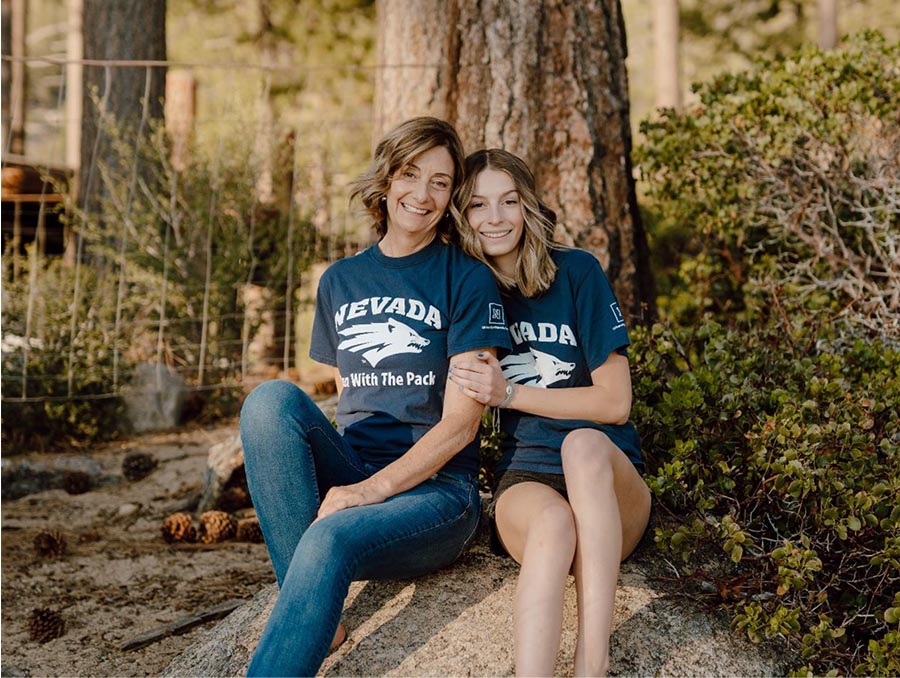Catriona “Cat” Black, ’95 Materials Science Engineering, is the 2023 recipient of the Scrugham Medal, awarded to alumni who have demonstrated success in their chosen profession. The medal will be conferred at homecoming events this fall.
"I have known Cat since she started as an engineering student at the University,” College of Engineering Associate Dean Indira Chatterjee said. “She was always so amazing to work with as she had many creative ideas and carried through with all her commitments.
“After she graduated, she never failed to maintain contact with me,” Chatterjee, who nominated Black for the award, continued. “She is highly regarded by her colleagues in industry. She definitely deserves this honor and the College of Engineering is very proud of such an alumna.”
Celebrating the honor will be one of the newest members of the Wolf Pack: Black’s daughter, Josie, a freshman at the University of Nevada, Reno, as well as her son Ben, a mechanical engineer and graduate of Embry-Riddle Aeronautical University.
Engineering: “an amazing choice for women”
The first graduate in the then-new Materials Science program, Black has worked as a product engineer and process engineer in various industries in northern Nevada, most recently as the director of Federal Operations Business Process Outsourcing (BPO) at Microsoft. Throughout her academic and professional career, she has supported her fellow women engineers, a commitment dating back to her college years, when she got involved with the student chapter of the Society of Women Engineers (SWE).
“I feel passionate about engineering as an amazing choice for women,” Black said. “You get to be creative. You get paid money to be creative. You’re doing design work based on (scientific) truth. It’s like being an artist with a different set of tools.”
For Black, engineering might have seemed the obvious choice: her older brother and sister both are chemical engineers, and her father, James Telford, was a physics professor at the University and at the Desert Research Institute. Black’s path was a little more circuitous: after graduating Reno High School and volunteering with the Washoe County Sheriff’s Office Hasty Team, a volunteer search-and-rescue group, she spent a few years working in law enforcement. But at age 23, her path led back to engineering and to the University.
“I came back to engineering because I was darn good at it,” she said.
Opportunity and support
Originally studying mechanical engineering, Black switched to materials science after a class in the topic piqued her interest, and found a mentor in Mackay School of Mines Dean Dick Bradt. (At that time, materials science still was associated with the Mackay School of Mines; Chemical & Materials Engineering now is a department within the College of Engineering.) During those years, she met Chatterjee, whom Black says was the only female engineering professor at the University.
In the early 1990s, engineering did not always seem welcoming of women, Black recalled, but between Chatterjee and Bradt, she was afforded opportunity and support: she co-authored journal-published research papers and got involved in the University’s SWE chapter.
Within SWE, Black took on many roles, including that of newsletter editor, a position in which she and a fellow SWE member produced an Internet-based newsletter (new at the time) funded by Apple. She also served as chapter president and was active in raising funds for the group so that seniors could attend the national SWE conference, an experience she recalled as one of her fondest University memories.
“It was dynamic and fun,” she said.
Growth and change
After graduating in 1995, she worked at Precision Castparts and then Tripp Enterprises before moving on to Microsoft, her current employer. Often the only woman on leadership teams, Black mentored up-and-coming women engineers through SWE as well as on the job. And while engineering remains a male-dominated field — only 21% of engineering majors are women, according to the American Association of University Women report The STEM Gap — Black welcomes the progress she has seen since she was an undergrad: “I think we have evolved away from the notion engineering isn’t for women.”
Along with social change, Black also has witnessed physical changes of the University campus. When she was a child in the 1970s, her father would drive to the Leifson Physics building and park in front of it to go to work. When she was a student here in the 1990s, the College of Engineering was centered mostly in the Scrugham Engineering and Mines building and the Palmer Engineering Building. The William Pennington Engineering Building, which currently houses most of the College of Engineering labs as well as the Computer Science & Engineering Department, was decades in the future, along with the Knowledge Center, the Joe Crowley Student Union and many other structures.
“The growth of this University is just amazing,” Black said. “I can’t wait to see it through my daughter’s eyes.”














